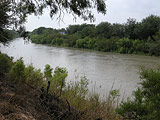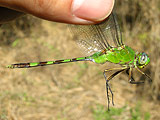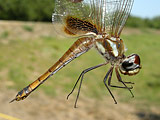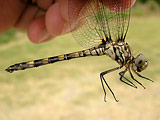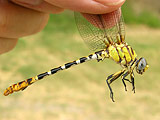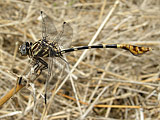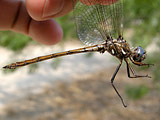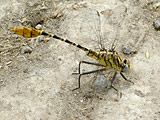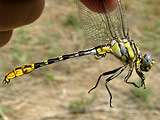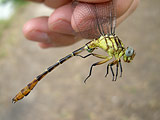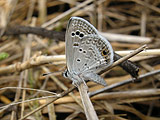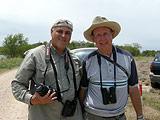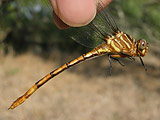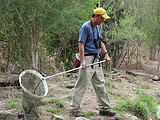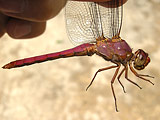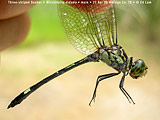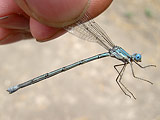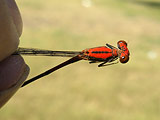
South Texas, April 23 - 29, 2008

Wednesday, Apr 23
I admit I was not terribly excited as I began my first dragonfly trip of the year. I had limited expectations since the week was built entirely around the slim possibility of finding a single rare species. And I worried about the drought plaguing south Texas. On top of that when I got to the airport, my 7:20 AM flight to Houston had been cancelled. The excuse was an unnamed mechanical problem. I wasn't too surprised with all the bad press the airline industry has been getting lately. They put me on another flight on another airline and after connecting in Dallas, arrived in McAllen at 2 PM central time.
I picked up the rental car, set the GPS, and headed to the Santa Ana National Wildlife Refuge. It was hot and breezy. I knew it would be dry since the spring rains had not come. The lower Rio Grande Valley had not gotten any significant rainfall since October and the grass was brown, the trails hard and gray yet it was not lifeless. Grackles and blackbirds squabbled. A Buff-bellied Hummingbird fed at a feeder. On the canal I found my first damselflies, Blue-ringed Dancers Argia sedula. In the sheltering lee of the trees flew Wandering and Spot-winged Gliders Pantala flavescens and hymenea, and Striped Saddlebags Tramea calverti. It took me a while to catch a saddlebags. I had not swung a net since October and I was rusty. There were dozens of Great Pondhawks Erythemis vesiculosa but little else but the scurry of lizards as I made my way to the Rio Grande River. Along this river I was hoping to find the main target of the trip, a species that has been recorded only in April, the Tamaulipan Clubtail, Gomphus gonzalezi, and a species that no one seems to be able to find.
Thursday, Apr 24
The last person to see a Tamaulipan Clubtail is Dave Hanson, a wintertime resident of Mission, TX. He caught and photographed a female in April of 2006. When the pictures made the rounds, others came looking without success. I joined Dave for breakfast along with David and Jan Dauphin, also residents of the Valley and great nature enthusiasts. They had generously offered to show me the dragonfly hotspots particularly those off the usual birding and butterflying map. We headed first to a spot along the river where, a week and a half ago while looking for Tamaulipan Clubtail, Martin Reid photographed a darner dragonfly that had never been seen before in the US.
It was a nice place to start. We heard thunder but there was no rain. Although it was windy, we found quite a few species as the morning warmed up. We did see a darner, a Coryphaeschna like the apeoria Martin saw but ours was adnexa, Blue-faced Darner. Black Setwings Dythemis nigrescens, Band-winged Dragonlets Erythrodiplax umbrata, and Roseate Skimmers Orthemis ferruginea were fairly common down in the brush. Flying among the trees, the saddlebags and gliders were joined by a few Hyacinth Gliders Miathyria marcella. I was pleased to see a couple of Straw-colored Sylphs Macrothemis inacuta and managed to net two males out of the air with one swing. But clubtails were our main focus. We saw an Eastern Ringtail Erpetogomphus designatus, and several male Five-striped Leaftails Phyllogomphoides albrighti. The Leaftails were immature but their big clubs were still impressive. We were also finding teneral females clubtails and they stumped me for a while. Their markings and long proportions looked so much like Russet-tipped Clubtail Stylurus plagiatus. But being from the Northeast I don't expect to see this species until late in the summer so it took a careful examination of the specimens back at the motel to convince me of their identity.
We then stopped at Estero Llano Grande State Park where we added Eastern Amberwing Perithemis tenera and Red-tailed Pennant Brachymesia furcata to the list. We might have done better but the wind was blowing fiercely.
We stopped at a pond at Santa Ana next where I saw the only other darner of the trip, a Common Green Anax junius. Flying amid the vegetation on the pond were both Great and Pin-tailed Pondhawks Erythemis plebeja along with Blue and Thornbush Dashers, Pachydiplax longipennis and Micrathyria hageni. In a garden next to the pond I caught a female Five-striped Leaftail.
Our final stop was a canal near Anzalduas County Park where we found some Rambur's Forktails Ishnura ramburii and a lone male Caribbean Yellowface Neoerythromma cultellatum. It had gotten cloudy. In the brush we found a couple of teneral clubtails which turned out to be Sulphur-tipped Gomphus militaris. The Dauphins had to leave around 3:30 but I stuck around the canal for a short while longer and found a newly emerged female Spinylegs presumably Flag-tailed, Dromogomphus spoliatus. So young and pale, it had no markings but the long spines on its hindlegs gave away its identity.
Friday, Apr 25
I was at Anzalduas County Park the next morning. It was warm and humid and still breezy as I worked my way slowly along the Rio Grande. Smoky Rubyspots Hetaerina titia perched on vegetation overhanging the water along with a few Neotropical Bluets Enallagma novaehispaniae, a species new to me. Dancers Argia were common represented by the Powdered, Blue-fronted, Blue-ringed and Dusky, moesta, apicalis, sedula, and translata respectively. Another new species (and a new family) were the red Amelia's Threadtails Neoneura amelia that hovered low over the water. I made only a half-hearted attempt to catch one since the steep banks made the effort less than inviting.
There were more immature Russet-tipped Clubtails in the trees along the water's edge including some males. The grassy areas near the river produced a few more species, Eastern Ringtail, Sulphur-tipped Clubtail, and Flag-tailed Spinylegs. Some clubtails flushed and flew away (undoubtably those were the Tamaulipans).
At midday I headed to Bentsen State Park where Josh Rose was leading a dragonfly walk. Completely unplanned, the other participants of the walk were Dave Hanson and the Dauphins. We checked out the pond near the visitor center adding Desert Firetail Telebasis salva to my trip/Texas/year list then hopped on the tram to look for Carmine Skimmer Orthemis discolor. This species closely resembles the purple pink Roseate Skimmer and Josh had a spot for it. It was a tiny eagle scout-made pool fed by a green water hose but when we got there at least 3 male Carmine Skimmers were dogfighting for ownership. A female arrived and was quickly grabbed by one of the males. She laid her eggs rapidly while being harrassed by the others. With all eyes on me I took my time to catch one of the males. They seemed pretty determined to stay at the pond but I wasn't sure they would not disappear if I swung and missed.
We tried a larger body of water and a nearby garden for Spot-tailed Dasher Micrathyria aequalis. We saw a couple of males but not the female I needed. I spotted a male Flag-tailed Spinylegs that everyone got to photograph and I was pleased that it was a lifer for Josh.
We dispersed shortly afterwards but I went back to the little pool to look for a female Carmine Skimmer. One was ovipositing when I arrived but my net was not assembled. By 4:30 PM the males had gone from the pool so I had to give up too.
Saturday, Apr 26
I woke up to an unusual sight for South Texas. It was raining. It didn't rain very hard or for very long but it remained cloudy and I wasn't sure where I should go for the day. I thought about going west to Salineno to look for the Tamaulipan. It would take an hour to get there and maybe the weather would improve. I gassed up to go but as I was pulling out of the filling station who should be driving by but Dave Hanson. I was in no hurry so we stopped and had breakfast, I got to visit his home, meet his dogs, and see more of his dragonfly photos. As we were talking I could see a shadow form in his yard as the sun was beginning to peek out. We decided to visit NABA International Butterfly Park, the site where he photographed the female Tamaulipan two years ago. By the river we ran into Gil Quintanilla and spent a couple of hours looking for dragonflies. We didn't find anything new but I enjoyed the company and views of Groove-billed Anis.
After lingering in the NABA gardens watching more birds and butterflies, I had to get back to work and headed to Bentsen to try for a female Carmine Skimmer but by time I got there the clouds had moved in.
Sunday, Apr 27
Since the forecast was for more clouds and rain, I was surprised to find it sunny when I woke up. I quickly gathered my gear and headed back to the spot where Martin Reid found the new darner. There was less wind than my first visit but it was warm and humid. The aerial species like the gliders and saddlebags were conspicuously absent. But the first clubtail I found in the grass was different, a female Narrow-striped Forceptail Aphylla protracta. There were a handful of Russet-tipped Clubtails and Five-striped Leaftails but then I spotted a small clubtail perched in a mesquite which I managed to net without getting caught on the thorns. It was a young male Ringed Forceptail Phyllocycla breviphylla a species I wanted to see but did not expect so early in the year. As it got hot what little activity ceased.
I went down the road to Santa Ana and rechecked the pond by the entrance. There were dashers along the edge and I netted one thinking that it was a Thornbush Dasher. As I photographed it in the hand I noticed its eyes were green without any hint of blue and the stripes on the thorax were straight. It was a Three-striped Dasher Micrathyria didyma. I looked for the species last October in Florida without success. Scanning the pond I saw another male.
For the next three hours I walked the trails at Santa Ana around Pin-tail Lake and along the Rio Grande. I found a female Rainpool Spreadwing Lestes forficula at a little pool (of course) but there was little in way of dragonflies. I did have my third and best view of a male Painted Bunting for the trip.
Monday, Apr 28
It rained hard during the night. It was much needed but while driving to the "Darner spot" I got worried when my wheels spun in the mud on the dirt road. Maybe I could get some help from the Border Patrol if I got stuck. It was much cooler and I had to wait until the clouds allowed the sun to shine through. There were even fewer dragonflies than the day before. I saw a Straw-colored Sylph which I thought was a female as it flew away. I caught a female Thornbush Dasher and another female Narrow-striped Forceptail. Still this location was one of the richest spots for dragonflies I visited during the week. Unfortunately if the proposed border wall goes up there would be no access to what is now public land.
I headed back to Santa Ana to look for female dashers and founding none, headed to Bentsen for one last shot at female Carmine Skimmer. I had a couple of swings at a pair as the female dipped furiously to lay eggs while the male guarded her closely. I heard wings rattling in the net but I had caught the male and missed the female.
Tuesday, Apr 29
For my last morning of the trip, I returned to Anzalduas County Park. Those unidentified clubtails flying off during my last visit gave me hope that a Tamaulipan just might be lurking in the grass. But as the clock ran out on this trip I didn't see any clubtails of any kind all morning.
It was a strange trip. It is always a bit of a shock going from the cool of the Northeastern spring to the heat of the South. Suddenly swatting away mosquitoes again, picking out ticks, and keeping an eye out for poisonous snakes. Then the rain followed me. But despite not finding my primary target, I did pretty well and will be returning to Texas later in the season.
I am grateful for the guidance and company of Dave Hanson, David & Jan Dauphin, Gil Quintanilla, and Josh Rose. Thanks to Mitch Sternberg for permission to survey and collect at Santa Ana/LRGV NWR and David Riskind for permission to collect and survey at Texas State Parks.
Dave Hanson's website
David and Jan Dauphin's website
Martin Reid's website
